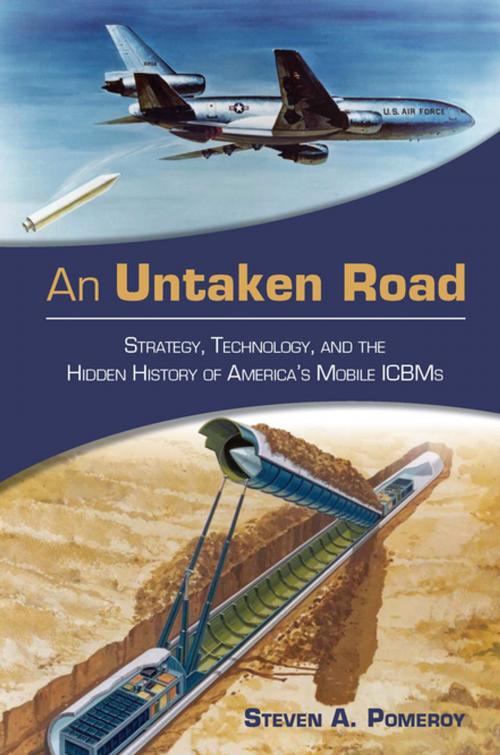An Untaken Road
Strategy, Technology, and the Hidden History of America's Mobile ICBMs
Nonfiction, History, Military, Weapons| Author: | Steven A. Pomeroy | ISBN: | 9781612519920 |
| Publisher: | Naval Institute Press | Publication: | January 15, 2016 |
| Imprint: | Naval Institute Press | Language: | English |
| Author: | Steven A. Pomeroy |
| ISBN: | 9781612519920 |
| Publisher: | Naval Institute Press |
| Publication: | January 15, 2016 |
| Imprint: | Naval Institute Press |
| Language: | English |
The history of the American mobile intercontinental ballistic missile (ICBM) reveals the interactions of strategy, technology, and context. Its tale began with nuclear strategists demanding second-strike weapons to ensure national survival. Many, including Presidents Eisenhower, Kennedy, and Reagan, drew confidence from ICBMs housed within underground silos. Others, among them Air Force General Bernard Schriever, Princeton mathematician John von Neumann, and Presidents Ford and Carter, thought otherwise. Accordingly, from 1956 until the Soviet Union’s demise, Americans created mobile ICBMs no enemy could target. Their invention, diffusion, and growth nearly resulted in trains shuffling 300 Minuteman ICBMs across the country. Later, officers and politicians planned ICBM subways, air-launched missiles, bases under mountains, and submarines within inland seas. But, the ultimate mobile ICBM was the 1980s-era MX doomsday machine,” a state-sized weapon system that public opposition finally defeated. Even though a technological system such as a mobile ICBM force may remain unbuilt, the associated efforts of four decades and billions of dollars did not occur within a vacuum. Mobile ICBMs have significantly shaped American nuclear strategy and forces.
An Untaken Road develops a new conceptual framework on the nature of strategic weapons technology innovation. This thorough study of a road not taken” for major USAF mobile nuclear missile programs applies to those seeking to understand the challenges and constraints on U.S. military weapon programs, including those in the U.S. Navy. The impressive framework builds upon various scholarly works on technological innovation in the realms of nuclear and non-nuclear weapons. The result offers decision-makers, program managers, defense planners, and scholars a new way of thinking about how defense organizations must unite strategy, technology, and innovation within a challenging external context involving intra- and inter-organization competition, along with domestic politics. The book’s lessons are germane, and today, Air Force leaders are re-examining mobile ICBMs as potential replacements for the silo-based Minuteman III.
An Untaken Road develops a new conceptual framework on the nature of strategic weapons technology innovation. This thorough study of a road not taken” for major USAF mobile nuclear missile programs applies to those seeking to understand the challenges and constraints on U.S. military weapon programs, including those in the U.S. Navy. The impressive framework builds upon various scholarly works on technological innovation in the realms of nuclear and non-nuclear weapons. The result offers decision-makers, program managers, defense planners, and scholars a new way of thinking about how defense organizations must unite strategy, technology, and innovation within a challenging external context involving intra- and inter-organization competition, along with domestic politics. The book’s lessons are germane, and today, Air Force leaders are re-examining mobile ICBMs as potential replacements for the silo-based Minuteman III.
The history of the American mobile intercontinental ballistic missile (ICBM) reveals the interactions of strategy, technology, and context. Its tale began with nuclear strategists demanding second-strike weapons to ensure national survival. Many, including Presidents Eisenhower, Kennedy, and Reagan, drew confidence from ICBMs housed within underground silos. Others, among them Air Force General Bernard Schriever, Princeton mathematician John von Neumann, and Presidents Ford and Carter, thought otherwise. Accordingly, from 1956 until the Soviet Union’s demise, Americans created mobile ICBMs no enemy could target. Their invention, diffusion, and growth nearly resulted in trains shuffling 300 Minuteman ICBMs across the country. Later, officers and politicians planned ICBM subways, air-launched missiles, bases under mountains, and submarines within inland seas. But, the ultimate mobile ICBM was the 1980s-era MX doomsday machine,” a state-sized weapon system that public opposition finally defeated. Even though a technological system such as a mobile ICBM force may remain unbuilt, the associated efforts of four decades and billions of dollars did not occur within a vacuum. Mobile ICBMs have significantly shaped American nuclear strategy and forces.
An Untaken Road develops a new conceptual framework on the nature of strategic weapons technology innovation. This thorough study of a road not taken” for major USAF mobile nuclear missile programs applies to those seeking to understand the challenges and constraints on U.S. military weapon programs, including those in the U.S. Navy. The impressive framework builds upon various scholarly works on technological innovation in the realms of nuclear and non-nuclear weapons. The result offers decision-makers, program managers, defense planners, and scholars a new way of thinking about how defense organizations must unite strategy, technology, and innovation within a challenging external context involving intra- and inter-organization competition, along with domestic politics. The book’s lessons are germane, and today, Air Force leaders are re-examining mobile ICBMs as potential replacements for the silo-based Minuteman III.
An Untaken Road develops a new conceptual framework on the nature of strategic weapons technology innovation. This thorough study of a road not taken” for major USAF mobile nuclear missile programs applies to those seeking to understand the challenges and constraints on U.S. military weapon programs, including those in the U.S. Navy. The impressive framework builds upon various scholarly works on technological innovation in the realms of nuclear and non-nuclear weapons. The result offers decision-makers, program managers, defense planners, and scholars a new way of thinking about how defense organizations must unite strategy, technology, and innovation within a challenging external context involving intra- and inter-organization competition, along with domestic politics. The book’s lessons are germane, and today, Air Force leaders are re-examining mobile ICBMs as potential replacements for the silo-based Minuteman III.















